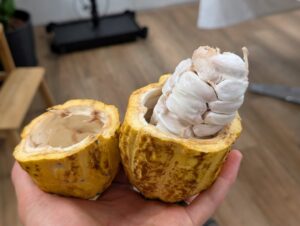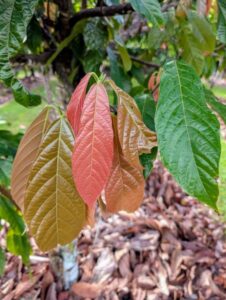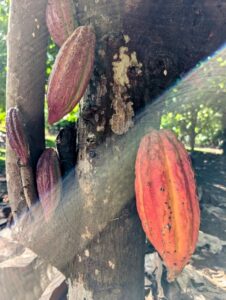
The case for cacao
By Caleb Roberts
Botanical name: Theobroma cacao
Common name: Cacao tree or cocoa tree
Family: Malvaceae

Origin: With a long history in the Amazon basin, cacao was traded as a currency well before chocolate coins hit supermarket shelves. First domesticated in the equatorial rainforest, these plants prefer a rich humus soil, well-draining with frequent rainfall a warm stable climate and protection from wind. With a narrow native range, there is a strong possibility of losing the wild Theobroma cacao population.
Description: A slender, erect tree, cacao is unlikely to get higher than 8m. The alternate leaves are large and simple and grow through a red flush to a glossy green up to 40cm long. The foliage is typically reduced to promote sun penetration to developing pods, but recent experience with Cyclone Jasper has shown better resilience in orchards less heavily pruned. Flowering occurs sporadically through the year, with the peak harvest season in November in northern Queensland. The fruit occurs as a hard football shaped pod ripening to orange/yellow or red/purple, depending on variety, and, when cracked open, contains a core of seeds on a corn cob like structure.
Cultural requirements: There are three main varieties under cultivation, ‘Criollo’, red skinned, from central America, ‘Trinitario’ a high-grade producer from Trinidad, and ‘Forastero’ from the Amazon basin. There are similar species which can be used in chocolate production, and to my knowledge nobody has attempted to select varieties. Less popular than cacao but just as interesting, there is ‘Mocambo’, T. bicolour, and T. cupuacu, from which the food produced is often called ‘cupulate’. These trees thrive in temperatures of 20-30oC with greater than 70% humidity.
Cultivation: Propagation is by seed. We have seen them germinating in mulched pods under the trees in the orchard. To emulate that, seeds should be soaked in fresh water (changed frequently) over three to four days to remove the pulp, until tiny white roots can be seen. Ideally, they are then planted at a slight angle in a light peat/perlite mix to prevent rot and are kept evenly moist while germinating. As with other tropical, large, seeded fruit, they can be prone to j-roots if left to find their own alignment when planting.

Ecological and cultural notes: Cacao is insect pollinated by tiny midges attracted to the slightly unpleasant smell of the flowers and can be established as a breeding population by mulching the orchard with the empty husks after harvest. The wood has also been used for fibre and paper production, and there are historical records of medicinal potential, the basis for some modern chocolate advertising.
Landscape and horticultural use: Cacao copes beautifully with a heavy hedge prune under production conditions. The glossy red flush on the striking large leathery leaves is a statement piece that would add a tropical talking point to most any garden, and the pods make a unique statement hanging from the trunk, or in the kitchen fruit bowl.
Maintenance: Orchards are often heavily pruned in a commercial context, keeping the sturdy stem and branch structure below two metres for easy harvest of the cauliflorous pods. The thick husk renders the fruit fairly safe from most pests, although fruit-spotting bugs can still leave their marks, and we do find aphids in the nursery setting. There is debate among the cacao industry as to whether they should be grown with shade rows or in full sun, and the water competition seems to be the deciding factor. I have seen a successful orchard thriving under full sun conditions, counter to the industry recommendation.
Caleb Roberts
Daleys Fruit Tree Nursery
W: www.daleysfruit.com.au
